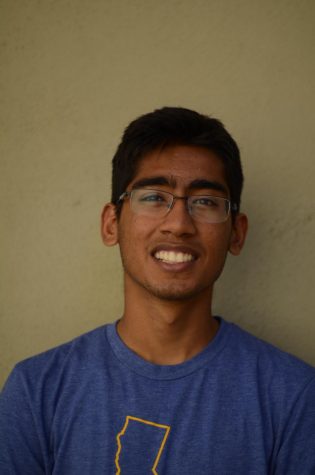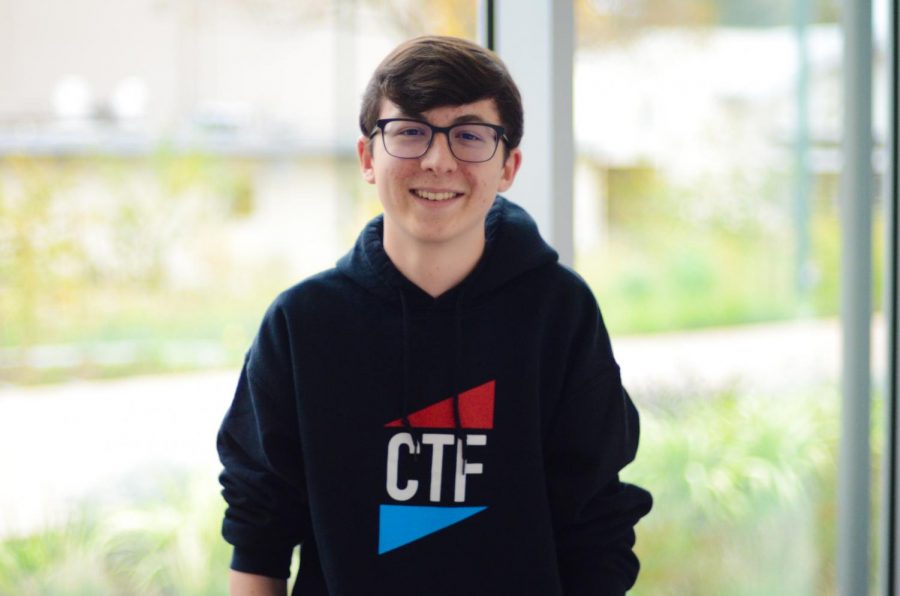Humans of Harker: A Saganist worldview
Cameron Jones asks the big questions
“About 100 years ago, we didn’t know what general relativity was. Then, in 1915, Einstein proposed it in a conference. And since then, our understanding of physics has changed drastically. Even in that relatively short period of time, looking at how much our knowledge has changed, it inspires me to be part of that next move, that next wave of understanding,” Cameron Jones (12) said.
Cameron Jones (12), wearing a black sweatshirt adorned with the Harker CTF logo, stares intently at his screen with glasses-framed eyes, constructing the applications that many students now take for granted. Whether it be a student council election that uses the voting system he helped write or the lottery to determine parking spots for juniors and seniors, his contributions have had an unmistakable impact on school life.
Cameron began programming when he was eight years old, with his grandfather teaching him programming in C using an Arduino, a type of microcontroller. Since then, he has taught himself several programming languages and has worked on numerous applications.
“What draws me to computer science is the freedom that it gives you. You’re not limited by the speed of the human mind, so you’re given infinite possibilities to explore the world around you through data or through really complex logic,” Cameron said. “Something that you spend a little bit of time on can be super powerful.”
Cameron, along with close friend Johnny Wang (12), founded two computer science-related Harker clubs: Harker CTF, which hosts an annual cybersecurity competition, and H-Crypt, which develops applications for everyday usage.
“He was [always] a strong programmer but he was more of a haphazard developer. He would throw things together in the most random way and they worked,” computer science teacher and faculty advisor for both of Cameron’s organizations Anu Datar said. “I saw a big change towards the end of his junior year and even now when he’s way more organized and he thinks things through. He spends more time on getting a good structure in place before actually starting to work.”
Johnny also commented on Cameron’s work ethic, poking fun at the extremes of his enthusiasm for a project.
“We were working on a product and he got really interested and he pretty much pulled an all-nighter to work on it. I told him to just chill [and that] we could finish this over a few days. But he was like ‘Nah, let’s do it now,’” Johnny said. “But when he’s not interested, he’s not going to write a single line of code.”
This attitude toward programming hints at the central motivation that drives most of Cameron’s pursuits—intellectual curiosity. Whether it be traveling, his annual science fair projects or an “absolute disrespect for alternative medicine,” according to close friend Raymond Banke (12), Cameron believes in a scientific perusal of the world modeled on the skeptic, empirical thinking of American astronomer Carl Sagan.
“He was filling out a Stanford application essay form, and they were asking for five words that describe yourself, and one of them he wanted to use was ‘Saganist.’ His beliefs really align with Carl Sagan and he really likes to question the validity of something based on its scientific accuracy, based on that logical truth,” Raymond Banke (12), one of Cameron’s closest friends, said.
This pursuit of the scientific method has materialized in Cameron’s research, as he has competitively participated in science fairs for about eight years. He has won several awards, beginning with a sixth grade project that made him a Broadcom MASTERS finalist. The project worked as a robotic gripper that required no prior information about the object it picked up and yet worked without a single algorithm.
“My project was dead simple: it used coffee grounds in a balloon and a vacuum pump. Those on their own seem kind of stupid, honestly, but combining them together in that project taught me how practical things can be used,” Cameron said.
Cameron’s diverse fields of interest — whether it be old sci-fi classics, astrophotography or research — have combined into his ultimate passion: aerospace engineering. Ever since he was young, Cameron closely followed the NASA missions and rovers to Mars; now, he has an admiration for Elon Musk and SpaceX and is working on analyzing astronomical spectra with machine learning for a Regeneron research paper.
“When molecules are excited, they will emit light at very specific frequencies in the infrared spectrum,” Cameron said. “So the idea is that by looking at data from stars or planets you can figure out the composition of atmospheres or gas clouds in space and learn a lot about our universe.”
The sheer volume of what humans do not know about the universe encourages Cameron to pursue his scientific inclinations.
“About 100 years ago, we didn’t know what general relativity was. Then, in 1915, Einstein proposed it in a conference. And since then, our understanding of physics has changed drastically. Even in that relatively short period of time, looking at how much our knowledge has changed, it inspires me to be part of that next move, that next wave of understanding,” Cameron said.

Aditya Singhvi (12) is a co-managing editor of Harker Aquila. This is his fourth year on staff. Outside of journalism, he enjoys running and watching...


















![“[Building nerf blasters] became this outlet of creativity for me that hasn't been matched by anything else. The process [of] making a build complete to your desire is such a painstakingly difficult process, but I've had to learn from [the skills needed from] soldering to proper painting. There's so many different options for everything, if you think about it, it exists. The best part is [that] if it doesn't exist, you can build it yourself," Ishaan Parate said.](https://harkeraquila.com/wp-content/uploads/2022/08/DSC_8149-900x604.jpg)




![“When I came into high school, I was ready to be a follower. But DECA was a game changer for me. It helped me overcome my fear of public speaking, and it's played such a major role in who I've become today. To be able to successfully lead a chapter of 150 students, an officer team and be one of the upperclassmen I once really admired is something I'm [really] proud of,” Anvitha Tummala ('21) said.](https://harkeraquila.com/wp-content/uploads/2021/07/Screen-Shot-2021-07-25-at-9.50.05-AM-900x594.png)







![“I think getting up in the morning and having a sense of purpose [is exciting]. I think without a certain amount of drive, life is kind of obsolete and mundane, and I think having that every single day is what makes each day unique and kind of makes life exciting,” Neymika Jain (12) said.](https://harkeraquila.com/wp-content/uploads/2017/06/Screen-Shot-2017-06-03-at-4.54.16-PM.png)








![“My slogan is ‘slow feet, don’t eat, and I’m hungry.’ You need to run fast to get where you are–you aren't going to get those championships if you aren't fast,” Angel Cervantes (12) said. “I want to do well in school on my tests and in track and win championships for my team. I live by that, [and] I can do that anywhere: in the classroom or on the field.”](https://harkeraquila.com/wp-content/uploads/2018/06/DSC5146-900x601.jpg)
![“[Volleyball has] taught me how to fall correctly, and another thing it taught is that you don’t have to be the best at something to be good at it. If you just hit the ball in a smart way, then it still scores points and you’re good at it. You could be a background player and still make a much bigger impact on the team than you would think,” Anya Gert (’20) said.](https://harkeraquila.com/wp-content/uploads/2020/06/AnnaGert_JinTuan_HoHPhotoEdited-600x900.jpeg)

![“I'm not nearly there yet, but [my confidence has] definitely been getting better since I was pretty shy and timid coming into Harker my freshman year. I know that there's a lot of people that are really confident in what they do, and I really admire them. Everyone's so driven and that has really pushed me to kind of try to find my own place in high school and be more confident,” Alyssa Huang (’20) said.](https://harkeraquila.com/wp-content/uploads/2020/06/AlyssaHuang_EmilyChen_HoHPhoto-900x749.jpeg)




Diana Moss • Mar 25, 2019 at 7:57 pm
Cameron….NASA is waiting for you! Billions and Billions of stars in the galaxy…. and you are definitely one of them!